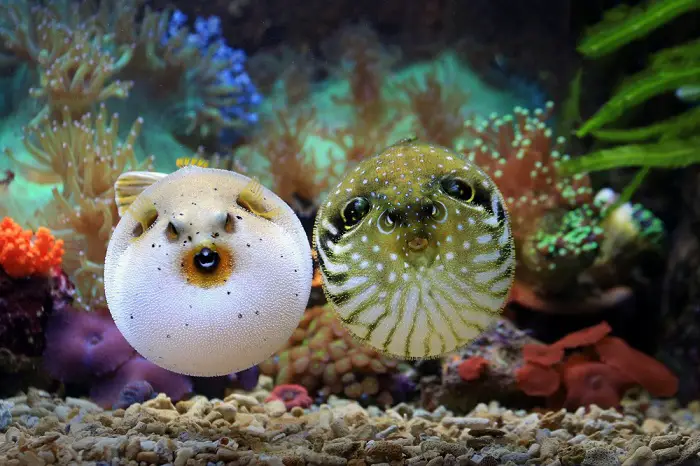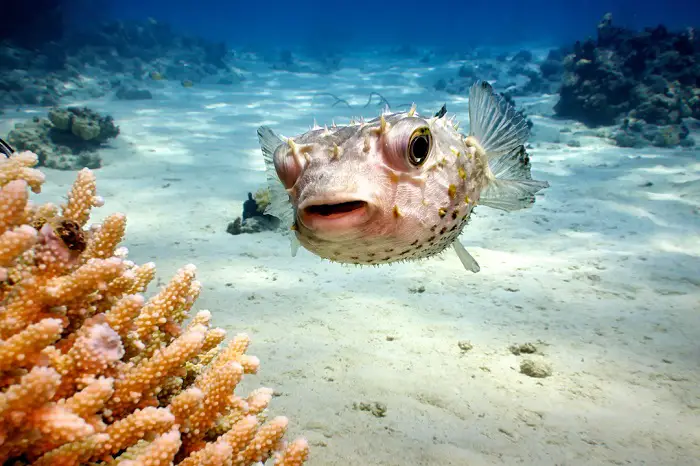Have you ever wondered about the secret life of puffer fish?
These fascinating creatures are known for their unique ability to puff up into a ball when threatened. But what do they eat in their underwater world?
In this blog post, we delve into the surprising diet of puffer fish and answer the burning question: do puffer fish eat other fish?
Prepare to be amazed by the predatory habits of these seemingly harmless little creatures.
Puffer Fish Diet: Omnivores of the Sea

Pufferfish, also known as blowfish or fugu in Japan, are fascinating creatures that inhabit both fresh and saltwater environments around the world.
Their unique diet sets them apart from other fish – they are omnivores, consuming a variety of plant matter and small aquatic animals.
While most people may associate puffer fish with their ability to inflate themselves when threatened, there is much more to these captivating creatures.
Despite their seemingly adorable appearance, puffer fish can be quite voracious eaters. They have strong jaws and sharp teeth that allow them to crunch through hard-shelled prey like mollusks and crustaceans.
Additionally, puffer fish have a particular fondness for marine vegetation such as algae and seagrasses. This diverse diet helps provide the necessary nutrients for their growth and development.
Interestingly, some species of puffer fish even possess a potent toxin called tetrodotoxin in certain parts of their bodies, like the liver and ovaries. This powerful neurotoxin acts as a natural defense mechanism against predators but poses a significant risk to humans if consumed improperly.
Despite this potential danger, various cultures worldwide still indulge in the delicacy of puffer fish dishes under strict regulations enforced by licensed chefs who undergo extensive training on how to carefully handle and prepare these toxic delicacies.
While the image of an inflated puffer fish may be what initially captures our attention, it’s equally important to appreciate their interesting dietary habits.
These omnivorous creatures play a crucial role in maintaining the balance of marine ecosystems by controlling the population of small invertebrates and algae.
Their ability to consume a wide range of food sources contributes to their adaptability and survival in different habitats.
Predatory Behavior: Do Puffer Fish Hunt Other Fish?
Pufferfish are widely known for their unique defense mechanism – puffing up into a spiky ball when threatened. However, it may come as a surprise to many that pufferfish also possess predatory tendencies.
While they primarily feed on small invertebrates and algae, some species have been observed hunting and consuming other fish.
One intriguing example is the pufferfish species known as the Immaculate Puffer. Recent studies have revealed that this feisty little fish will actively pursue unsuspecting prey, employing stealth and cunning techniques.
Using its keen eyesight, the Immaculate Puffer patiently waits for an opportune moment to strike, rapidly engulfing its prey in one quick motion.
Another notable case of pufferfish predation revolves around the iconic Figure Eight Puffer. Although they mainly rely on plant material for sustenance, these aggressive hunters are not averse to snacking on smaller fish either.
With their strong jaws and sharp teeth designed for crunching through shells and armored prey alike, Figure Eight Puffers blend stealth with brute force when ambushing their victims.
While many tend to view pufferfish solely as defenseless creatures inflating themselves out of harm’s way, they also possess predatory instincts that allow them to hunt other fish when necessary or advantageous.
These findings provide yet another reason to appreciate the diversity and complexity found within marine ecosystems – even seemingly unassuming creatures can harbor surprising behaviors beneath their cute exteriors. It is a reminder that nature never ceases to amaze us with its intricate web of life.
Hunting Techniques: How Puffer Fish Catch Their Prey

The puffer fish, also known as blowfish or fugu, may seem like a cute and innocent creature at first glance, but don’t let its appearance fool you. These fascinating fish have developed some unique hunting techniques to catch their prey.
One of the most remarkable methods used by puffer fish is their ability to inflate themselves into a spiky ball. When threatened or in pursuit of food, they swallow water rapidly, causing their bodies to expand in size and deter potential predators.
This inflation not only makes them appear much larger than they actually are but also exposes their sharp spines as added protection.
Another interesting hunting technique employed by puffer fish involves using toxins found in certain parts of their bodies. Certain species carry potent neurotoxins called tetrodotoxin within various organs such as the skin, liver, and ovaries.
Despite being highly toxic (and potentially lethal to humans if consumed), these toxins serve as a valuable defense mechanism for the puffer fish against predators. In fact, some reports suggest that just one puffer fish contains enough poison to kill 30 adult humans.
These specialized adaptations provide the puffer fish with a powerful advantage when it comes to catching prey or evading threats in their underwater habitat.
Puffer fish incorporate an array of unique hunting techniques that highlight their remarkable evolutionary adaptations.
By inflating themselves into an intimidating defense mechanism and utilizing potent toxins as deterrents against predators, these small yet skillful hunters manage to survive in diverse aquatic environments around the world.
Puffer Fish and Coral Reefs: Interactions with Fish Communities
Puffer fish are enigmatic creatures that play a crucial role in the complex ecosystem of coral reefs. While they may seem harmless, their interactions with fish communities are anything but ordinary.
These spiky-bodied fish possess a unique defense mechanism – the ability to inflate themselves into a ball-like shape when threatened. This adaptation not only deters predators but also creates opportunities for other fish species.
One fascinating interaction involves cleaning symbiosis between puffer fish and cleaner wrasses. These small, brightly colored wrasses feed on parasites and dead skin found on the bodies of larger fishes, including puffer fish.
In response to irritation or discomfort caused by these parasites, puffer fish will seek out cleaner wrasses who eagerly munch away at their bodies. This mutually beneficial relationship ensures the health and vitality of both species while providing an essential service to other members of the coral reef community.
Another aspect of puffer fish behavior is their role in maintaining ecological balance within the reef ecosystem. As voracious herbivores, they graze on algae that can overgrow corals if left unchecked. By keeping algal growth under control, puffer fish prevent competition for resources and create healthier conditions for corals to thrive.
Furthermore, research suggests that the feeding habits of some species of puffer fish help disperse coral reproductive materials by ingesting them and excreting them elsewhere on the reef during digestion.
Pufferfish add an element of intrigue and importance to coral reefs through their interactions with surrounding fish communities.
Can Puffer Fish Coexist with Other Fish in Aquariums?

Puffer fish are undoubtedly fascinating creatures, known for their unique appearance and intriguing behavior.
However, when it comes to sharing a tank with other fish, puffers can be quite challenging companions. While there have been cases where puffer fish successfully coexist with certain species, it is important to understand the risks and limitations involved.
One crucial factor to consider is the temperament of the puffer fish itself. Puffers have a reputation for being aggressive and territorial, which means they may pose a threat to smaller or more docile tank mates.
Additionally, puffer fish are notorious for nipping at the fins of other fish, causing stress and potential injury.
Another hurdle in keeping puffers with other fish lies in their dietary requirements. Pufferfish predominantly feed on meaty foods such as crustaceans and mollusks.
This makes it challenging to find compatible tank mates that share similar feeding habits without compromising the health of either species.
While it is not impossible for puffer fish to coexist peacefully with other aquarium inhabitants, careful research, planning, and consideration are required before attempting such an endeavor.
It may be wise to consult with experienced aquarists or seek advice from knowledgeable sources who can provide guidance on suitable tank setups and compatible species combinations.
Mitigating Puffer Fish Predation in Aquaculture
Puffer fish (also known as blowfish) are infamous for their deadly venom and inflated spiky appearance. But these quirky creatures also pose a significant challenge for aquaculture farmers.
Pufferfish are opportunistic feeders that can decimate an entire crop of fish within hours, leaving farmers with substantial financial losses. Consequently, effective mitigation strategies have become imperative to protect aquaculture yields.
One innovative approach being explored is the use of decoy puffer fish. By strategically scattering artificial puffer fish replicas throughout the farm, real puffer fish may be dissuaded from preying on the valuable stock.
This technique capitalizes on the territorial nature of puffer fish, potentially creating a perception of limited resources and encouraging them to seek food elsewhere.
Additionally, advances in technology offer hope for more refined control methods. Emerging research suggests that certain sound waves can disrupt predatory behavior in puffer fish by affecting their sensory systems.
By strategically deploying underwater speakers emitting targeted frequencies, researchers aim to create a deterrent effect and reduce predation rates in aquaculture settings.
Through novel approaches like decoys and acoustic interference, scientists and farmers alike are revolutionizing how we mitigate the impact of puffer fish predation in aquaculture.
As we continue to study these unique creatures and leverage technological advancements, we move closer to finding sustainable solutions that effectively protect our aquatic resources while ensuring the livelihoods of those who depend on them.
Do Puffer Fish Eat Other Fish? (Summary)
Puffer fish are fascinating creatures with unique feeding habits. While they primarily feed on invertebrates such as crustaceans and mollusks, there have been rare instances of puffer fish consuming smaller fish.
However, these cases are not the norm and should be considered exceptions rather than the rule.
Pufferfish have evolved their specialized diet to suit their physiological needs and are generally not aggressive predators towards other fish species.
Further research is needed to understand the specific circumstances under which puffer fish may consume other fish.
Understanding their dietary habits is crucial for conservation efforts and ensuring the balance of marine ecosystems.
Let us continue to explore and learn more about these intriguing creatures to protect their habitats and promote biodiversity in our oceans.
Other Blog Posts